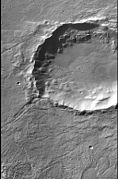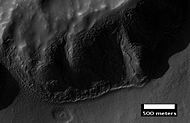Icaria Planum
39°40′S 130°00′W / 39.667°S 130.000°W / -39.667; -130.000[1]

Icaria Planum is a region on Mars in the Thaumasia quadrangle. It is located roughly south-southwest of the Tharsis Rise. Icaria Planum is named after the island of Ikaria, where, according to Greek mythology, Icarus fell and died in the sea.[1]
Icaria Planum is relatively ancient and cratered, with an estimated age of 3.59 billion years.[2]: 31 Some subsequent volcanic resurfacing occurred ~0.94 billion years ago, in the Middle Amazonian period.[3] Icaria Planum hosts numerous wrinkle ridges, a class of compressional faults thought to have formed from stresses in the Martian crust. The wrinkle ridges in Icaria Planum formed roughly 3.46 billion years ago and are largely concentric to the Tharsis Rise, likely due to the immense weight of the emplaced volcanic material as Tharsis formed.[4] Icaria Planum hosts an alluvial fan, likely due to the breach of an ancient paleolake from an impact crater close to the nearby Claritas Fossae.[5]
-
 CTX image from Icaria Planum that shows location of next image.
CTX image from Icaria Planum that shows location of next image. - Layers in mantle deposit, as seen by HiRISE, under the HiWish program. Mantle was probably formed from snow and dust falling during a different climate.
See also
- HiRISE
- HiWish program
- Latitude dependent mantle
- Thaumasia quadrangle
References
- ^ a b "Icaria Planum". Gazetteer of Planetary Nomenclature. USGS Astrogeology Research Program. (Center Latitude: -39.67°, Center Longitude: 230.00°)
- ^ Leone, Giovanni, ed. (27 October 2021). Mars: A Volcanic World (1st ed.). Springer Cham. ISBN 978-3-030-84102-7. Retrieved 29 April 2024.
- ^ Platz, Thomas; Michael, Gregory; Tanaka, Kenneth L.; Skinner, James A.; Fortezzo, Corey M. (July 2013). "Crater-based dating of geological units on Mars: Methods and application for the new global geological map". Icarus. 225 (1): 806–827. Bibcode:2013Icar..225..806P. doi:10.1016/j.icarus.2013.04.021.
- ^ Ruj, Trishit; Kawai, Kenji (November 2021). "A global investigation of wrinkle ridge formation events; Implications towards the thermal evolution of Mars". Icarus. 369. Bibcode:2021Icar..36914625R. doi:10.1016/j.icarus.2021.114625.
- ^ Raitala, J.; Korteniemi, J.; Aittola, M.; Kostama, V. -P.; Hauber, E.; Kronberg, P.; Neukem, G. (March 2006). Fluvial Activity Resulted in Alluvial Fan in Icaria Planum, Mars. 37th Annual Lunar and Planetary Science Conference. League City, Texas, United States. Bibcode:2006LPI....37.1299R. 1299.

- v
- t
- e
| Atmosphere |
|
|---|---|
| Regions | |
| Physical features |
|
| Geology |
|
| History |
| Moons |
|
|---|---|
| Transits |
|
| Asteroids |
|
| Comets |
|
| General |
| Concepts | |
|---|---|
| Missions | |
| Advocacy |
-
 Category
Category -
 Solar System portal
Solar System portal
 | This article about the planet Mars or its moons is a stub. You can help Wikipedia by expanding it. |
- v
- t
- e














